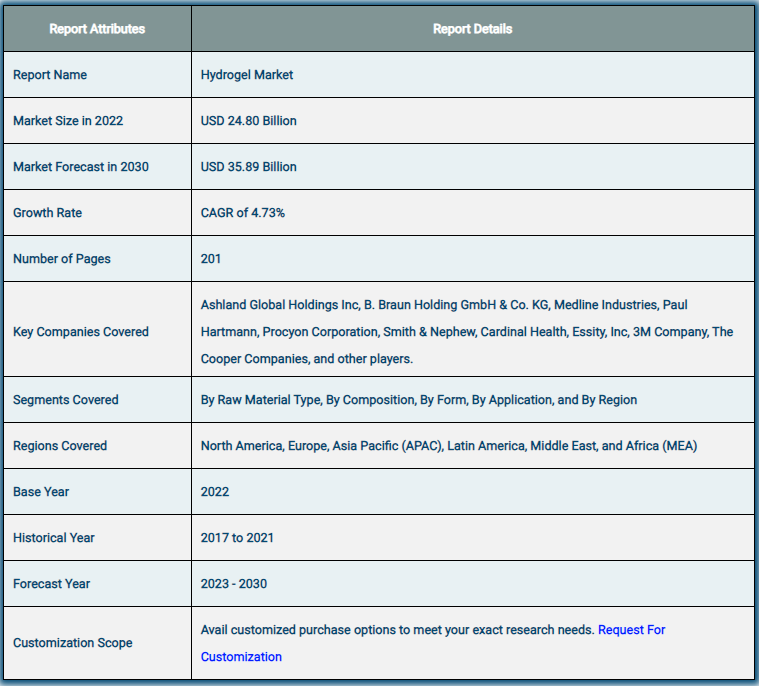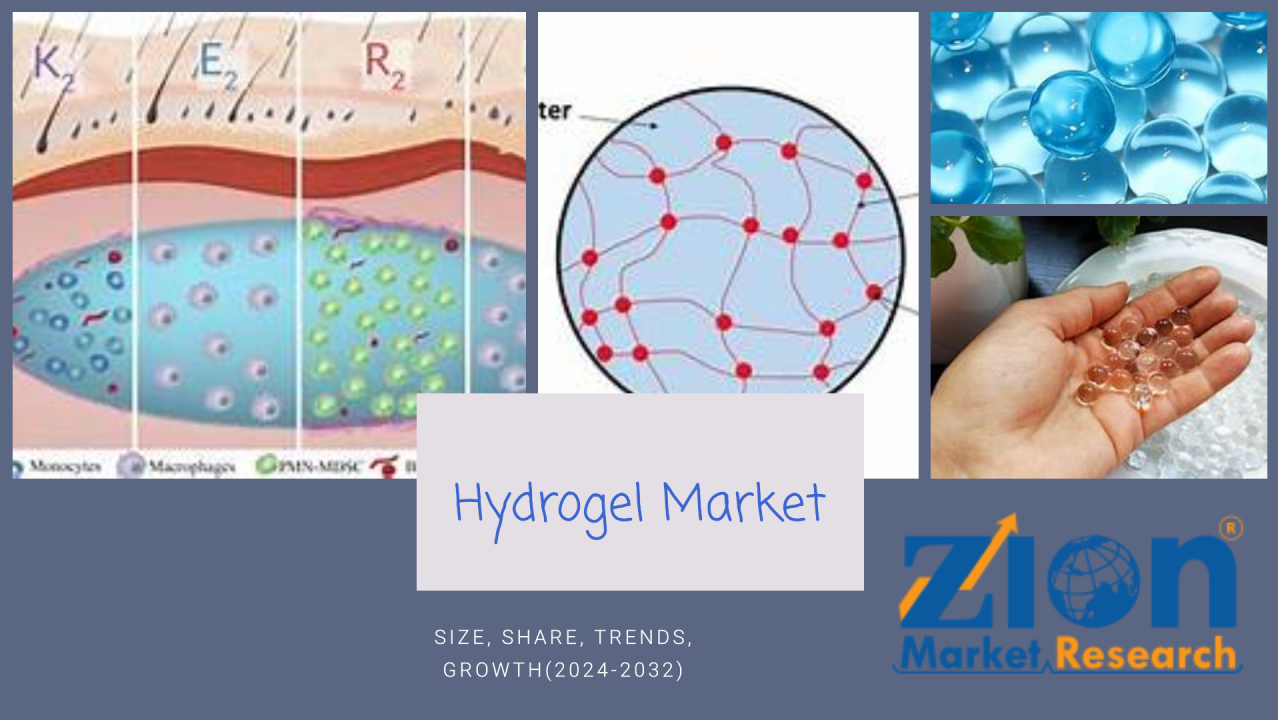The size of the global hydrogel market was estimated to be about USD 24.80 billion in 2024, and it is expected to increase at a compound annual growth rate (CAGR) of roughly 4.73% between 2024 and 2032 to be around USD 35.89 billion.
Introduction
The global hydrogel market has been growing steadily due to its wide range of applications in industries such as pharmaceuticals, healthcare, agriculture, and personal care. Hydrogels, known for their ability to retain large amounts of water, are used in various forms including wound dressings, drug delivery systems, and tissue engineering. Their unique properties — such as biocompatibility, flexibility, and absorbency — make them ideal for numerous industrial and medical applications. This article explores the current trends, key drivers, market challenges, and future outlook for the hydrogel market.
Overview of the Global Hydrogel Market
Hydrogels are three-dimensional polymeric networks capable of absorbing and retaining significant amounts of water or biological fluids. They can be synthesized from natural or synthetic polymers and are either physically or chemically cross-linked. Key applications of hydrogels include:
- Medical and Healthcare: Used in wound care, contact lenses, drug delivery systems, and tissue engineering.
- Personal Care: Found in products such as diapers, sanitary pads, and cosmetics.
- Agriculture: Utilized to retain water in soil and improve moisture retention for crops.
- Pharmaceuticals: Applied in controlled drug release formulations.
Hydrogel is a polymer that is insoluble in water and has the ability to hold onto large amounts of water, up to 95% of it in the gel state. Hydrogels are primarily used in a number of hygiene products, including adult incontinence pads, baby sanitary pads, diapers, and soft contact lenses.
 Hydrogel Market
Hydrogel Market
Growth Drivers for the Global Hydrogel Market
Hydrogel is used in wound care dressings to help clean wounds and debride necrotic tissues. They are also employed in the healing and management of burns, necrotic wounds, autolytic debridement, and partial or severe wounds. This can be attributed to the growing number of applications for hydrogel products, which is driving up demand in the hydrogel market. The hydrogel market is expanding due to the advantages of hydrogel over traditional/conventional replacements, rising product-based R&D activities by the leading market participants, and rising demand for hydrogel-based goods in emerging nations. Products made of hydrogel are evaluated to provide a number of benefits, including improved water retention, component preservation, and controlled release. Their use as a suitable material for the production of health and hygiene products, including soft contact lenses, diapers, injury care items, and drug delivery patches, has been encouraged by these key factors. Customers use these items extensively, which will eventually drive demand in the upcoming years for the global hydrogel market.
 Hydrogel Market
Hydrogel Market
Hydrogel Market Segmentation in the World
Five categories are used to categorize the global hydrogel market: composition, raw material type, product, form, and end user. The market is segmented into natural, synthetic, and hybrid hydrogels based on the kind of raw material used. The market is divided into five groups based on composition type: agar-based, silicone-modified hydrogels, polyacrylate, polyacrylamide, and others. The hydrogel market is divided into semi-crystalline and amorphous hydrogels based on the form in which the hydrogel is used. Four product categories make up the hydrogel market: hydrogel sheets, films & matrices, impregnated gauze, semi-crystalline buttons, and amorphous gels. The market is segmented based on end users, including tissue engineering, contact lenses, medication delivery, wound care, and hygiene products.
Hydrogel Industry: Report Purpose
 Hydrogel Market
Hydrogel Market
Worldwide Hydrogel Industry: Regional Evaluation
Because of the growing need for hydrogel in tissue engineering, biotechnology and medicine, agriculture, and other fields, North America is anticipated to have a dominant share of the hydrogel market.
The market for contact lenses is expected to grow quickly because of the rising production and use of these devices in the United States, Canada, and Mexico.
The hydrogel market is expected to grow at a faster rate in the tissue engineering segment in the near future.
The Asia Pacific region is expected to experience significant growth as a result of rising per capita income and population.
It is probable that the growing need for medication delivery systems, cleanliness and health care, agriculture, and other industries will lead to a faster growth rate for the synthetic hydrogel division.
Owing to these motivating factors, the hydrogel market is expected to be dominated by nations like China, India, and Japan.
Europe’s growing need for personal and healthcare products like paper towels, sanitary napkins, and newborn diapers is predicted to drive significant growth in the hydrogel industry.
Market Drivers
- Growing Demand in the Medical Sector The expanding healthcare industry is one of the major drivers for the hydrogel market. Hydrogels are increasingly being used in wound care due to their moisture-retentive properties that accelerate healing and prevent infection. Moreover, their application in drug delivery systems is gaining traction, as hydrogels can be engineered to release medications in a controlled manner.
- Increased Adoption in Personal Care Products The personal care sector is one of the largest consumers of hydrogels. Superabsorbent polymers (SAPs) are widely used in hygiene products such as baby diapers, adult incontinence products, and feminine hygiene items. The demand for such products is growing globally, particularly in emerging economies, boosting the hydrogel market.
- Technological Advancements in Hydrogel Production Innovations in hydrogel formulations and manufacturing processes have led to the development of advanced hydrogels with enhanced properties, such as self-healing, temperature sensitivity, and smart drug delivery capabilities. These advancements are opening new avenues for hydrogel applications across various sectors, including biotechnology and pharmaceuticals.
- Rising Interest in Smart Hydrogels Smart hydrogels, which respond to external stimuli such as temperature, pH, or light, are gaining popularity in fields such as biosensors, tissue engineering, and drug delivery. The ability to create hydrogels with tailored functionalities is driving interest from researchers and industries alike.
- Increased Focus on Sustainable Agriculture Hydrogels are increasingly used in agriculture to improve water retention in soil, particularly in regions prone to drought. These water-absorbing materials help reduce the frequency of irrigation and improve crop yields, aligning with global sustainability efforts in agriculture.
Market Trends
- Wound Care and Tissue Engineering: Hydrogels’ ability to mimic the extracellular matrix of human tissues is fueling their use in tissue engineering and regenerative medicine. The wound care segment, particularly for chronic wounds, is expected to see strong growth due to the growing elderly population and rise in diabetes-related wounds.
- Biodegradable and Eco-Friendly Hydrogels: As environmental concerns grow, there is increasing interest in developing hydrogels from natural, biodegradable materials. These eco-friendly alternatives are particularly relevant for agricultural and personal care applications.
- Hydrogels in Drug Delivery: The development of stimuli-responsive hydrogels, which can deliver drugs at specific sites or under particular conditions, is an exciting trend in pharmaceuticals. This innovation allows for more precise and efficient treatment, reducing side effects and improving patient outcomes.
- Hydrogels in Robotics and Soft Actuators: Hydrogels are finding new applications in the field of robotics and soft actuators due to their flexibility and ability to change shape when subjected to external stimuli. This is a growing niche market that is expected to expand with advancements in materials science.
Challenges
- High Production Costs Despite their growing demand, the cost of producing high-quality hydrogels can be prohibitive for some applications. The synthesis of specialized hydrogels, particularly those with advanced properties such as stimuli responsiveness, remains expensive due to the complexity of the production processes.
- Limited Mechanical Strength Traditional hydrogels tend to have low mechanical strength, which can limit their applications in fields that require durable materials. Research is ongoing to develop stronger, more resilient hydrogels that can withstand higher stresses while retaining their absorbent properties.
- Regulatory Challenges Hydrogels used in medical and pharmaceutical applications must meet stringent regulatory requirements before they can be marketed. These regulatory hurdles can slow down the commercialization of new hydrogel products, particularly in highly regulated markets such as the United States and Europe.
Future Outlook
The hydrogel market is expected to grow at a CAGR of X% from 2024 to 2030, driven by technological advancements, expanding applications in healthcare and agriculture, and increasing demand for personal care products. Key growth opportunities are likely to arise from:
- Expansion of Medical Applications: The demand for hydrogels in wound care, drug delivery, and tissue engineering is expected to drive future market growth. Innovations in biocompatible and biodegradable hydrogels will further expand their use in medical devices and therapies.
- Sustainability Initiatives in Agriculture: The agricultural sector will increasingly turn to hydrogels to address water scarcity and improve crop yields, particularly in developing countries facing climate-related challenges. Environmentally friendly, biodegradable hydrogels will play a key role in sustainable farming practices.
- Emergence of Smart Hydrogels: The development of hydrogels that respond to environmental stimuli (e.g., temperature, pH) will drive new applications in drug delivery, robotics, and biosensors, positioning hydrogels as a key material in next-generation technologies.
Conclusion
The hydrogel market is poised for substantial growth in the coming years, driven by increasing demand in healthcare, personal care, and agriculture sectors. Technological advancements and the development of smart and biodegradable hydrogels will unlock new opportunities, while challenges such as production costs and regulatory hurdles will need to be addressed. Companies focusing on innovation and sustainability will be well-positioned to capitalize on the market’s potential.
Contact Us:
Zion Market Research212
USA/Canada Toll Free: 1 (855) 465–4651
Newark: 1 (302) 444–016611\
Web: https://www.zionmarketresearch.com/
Blog: https://zmrblog.com/
